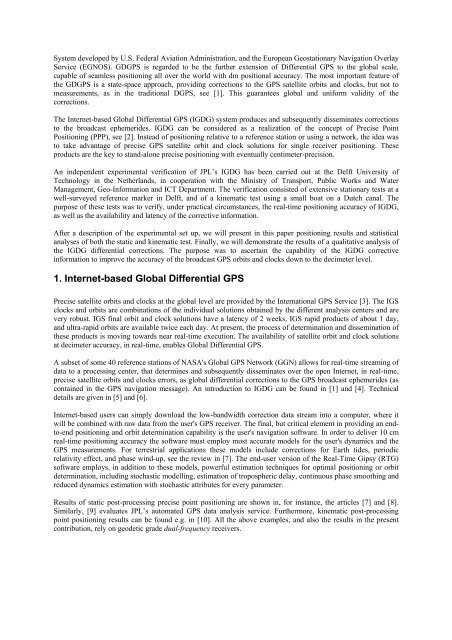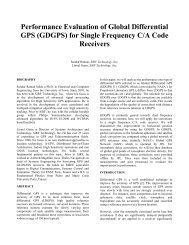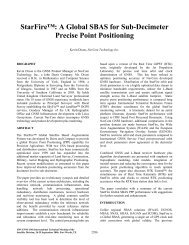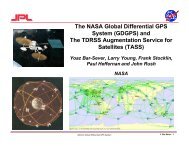Real-time kinematic positioning with NASA's Internet-based ... - gdgps
Real-time kinematic positioning with NASA's Internet-based ... - gdgps
Real-time kinematic positioning with NASA's Internet-based ... - gdgps
You also want an ePaper? Increase the reach of your titles
YUMPU automatically turns print PDFs into web optimized ePapers that Google loves.
System developed by U.S. Federal Aviation Administration, and the European Geostationary Navigation Overlay<br />
Service (EGNOS). GDGPS is regarded to be the further extension of Differential GPS to the global scale,<br />
capable of seamless <strong>positioning</strong> all over the world <strong>with</strong> dm positional accuracy. The most important feature of<br />
the GDGPS is a state-space approach, providing corrections to the GPS satellite orbits and clocks, but not to<br />
measurements, as in the traditional DGPS, see [1]. This guarantees global and uniform validity of the<br />
corrections.<br />
The <strong>Internet</strong>-<strong>based</strong> Global Differential GPS (IGDG) system produces and subsequently disseminates corrections<br />
to the broadcast ephemerides. IGDG can be considered as a realization of the concept of Precise Point<br />
Positioning (PPP), see [2]. Instead of <strong>positioning</strong> relative to a reference station or using a network, the idea was<br />
to take advantage of precise GPS satellite orbit and clock solutions for single receiver <strong>positioning</strong>. These<br />
products are the key to stand-alone precise <strong>positioning</strong> <strong>with</strong> eventually cen<strong>time</strong>ter-precision.<br />
An independent experimental verification of JPL’s IGDG has been carried out at the Delft University of<br />
Technology in the Netherlands, in cooperation <strong>with</strong> the Ministry of Transport, Public Works and Water<br />
Management, Geo-Information and ICT Department. The verification consisted of extensive stationary tests at a<br />
well-surveyed reference marker in Delft, and of a <strong>kinematic</strong> test using a small boat on a Dutch canal. The<br />
purpose of these tests was to verify, under practical circumstances, the real-<strong>time</strong> <strong>positioning</strong> accuracy of IGDG,<br />
as well as the availability and latency of the corrective information.<br />
After a description of the experimental set up, we will present in this paper <strong>positioning</strong> results and statistical<br />
analyses of both the static and <strong>kinematic</strong> test. Finally, we will demonstrate the results of a qualitative analysis of<br />
the IGDG differential corrections. The purpose was to ascertain the capability of the IGDG corrective<br />
information to improve the accuracy of the broadcast GPS orbits and clocks down to the decimeter level.<br />
1. <strong>Internet</strong>-<strong>based</strong> Global Differential GPS<br />
Precise satellite orbits and clocks at the global level are provided by the International GPS Service [3]. The IGS<br />
clocks and orbits are combinations of the individual solutions obtained by the different analysis centers and are<br />
very robust. IGS final orbit and clock solutions have a latency of 2 weeks, IGS rapid products of about 1 day,<br />
and ultra-rapid orbits are available twice each day. At present, the process of determination and dissemination of<br />
these products is moving towards near real-<strong>time</strong> execution. The availability of satellite orbit and clock solutions<br />
at decimeter accuracy, in real-<strong>time</strong>, enables Global Differential GPS.<br />
A subset of some 40 reference stations of <strong>NASA's</strong> Global GPS Network (GGN) allows for real-<strong>time</strong> streaming of<br />
data to a processing center, that determines and subsequently disseminates over the open <strong>Internet</strong>, in real-<strong>time</strong>,<br />
precise satellite orbits and clocks errors, as global differential corrections to the GPS broadcast ephemerides (as<br />
contained in the GPS navigation message). An introduction to IGDG can be found in [1] and [4]. Technical<br />
details are given in [5] and [6].<br />
<strong>Internet</strong>-<strong>based</strong> users can simply download the low-bandwidth correction data stream into a computer, where it<br />
will be combined <strong>with</strong> raw data from the user's GPS receiver. The final, but critical element in providing an endto-end<br />
<strong>positioning</strong> and orbit determination capability is the user's navigation software. In order to deliver 10 cm<br />
real-<strong>time</strong> <strong>positioning</strong> accuracy the software must employ most accurate models for the user's dynamics and the<br />
GPS measurements. For terrestrial applications these models include corrections for Earth tides, periodic<br />
relativity effect, and phase wind-up, see the review in [7]. The end-user version of the <strong>Real</strong>-Time Gipsy (RTG)<br />
software employs, in addition to these models, powerful estimation techniques for optimal <strong>positioning</strong> or orbit<br />
determination, including stochastic modelling, estimation of tropospheric delay, continuous phase smoothing and<br />
reduced dynamics estimation <strong>with</strong> stochastic attributes for every parameter.<br />
Results of static post-processing precise point <strong>positioning</strong> are shown in, for instance, the articles [7] and [8].<br />
Similarly, [9] evaluates JPL’s automated GPS data analysis service. Furthermore, <strong>kinematic</strong> post-processing<br />
point <strong>positioning</strong> results can be found e.g. in [10]. All the above examples, and also the results in the present<br />
contribution, rely on geodetic grade dual-frequency receivers.





